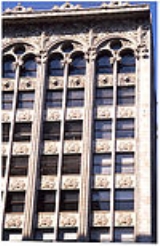
Bayard-Condict Building
Overview
Bleecker Street
Bleecker Street is a street in New York City's Manhattan borough. It is perhaps most famous today as a Greenwich Village nightclub district. The street is a spine that connects a neighborhood today popular for music venues and comedy, but which was once a major center for American bohemia.Bleecker...
between Broadway
Broadway (New York City)
Broadway is a prominent avenue in New York City, United States, which runs through the full length of the borough of Manhattan and continues northward through the Bronx borough before terminating in Westchester County, New York. It is the oldest north–south main thoroughfare in the city, dating to...
and Lafayette Street
Lafayette Street (Manhattan)
Lafayette Street is a major north-south street in New York City's Lower Manhattan, which runs roughly parallel to Broadway to the west. Originally, the part of the street below Houston Street was called Elm Place....
, at the head of Crosby Street in the NoHo
NoHo
NoHo, for North of Houston Street is a neighborhood in the New York City borough of Manhattan, roughly bounded by Houston Street on the south, The Bowery on the east, Astor Place on the north, and Broadway on the west. NoHo is wedged between Greenwich Village, west of Broadway, and the East Village...
neighbourhood of Manhattan
Manhattan
Manhattan is the oldest and the most densely populated of the five boroughs of New York City. Located primarily on the island of Manhattan at the mouth of the Hudson River, the boundaries of the borough are identical to those of New York County, an original county of the state of New York...
, New York City
New York City
New York is the most populous city in the United States and the center of the New York Metropolitan Area, one of the most populous metropolitan areas in the world. New York exerts a significant impact upon global commerce, finance, media, art, fashion, research, technology, education, and...
is the only work of architect Louis Sullivan
Louis Sullivan
Louis Henri Sullivan was an American architect, and has been called the "father of skyscrapers" and "father of modernism" He is considered by many as the creator of the modern skyscraper, was an influential architect and critic of the Chicago School, was a mentor to Frank Lloyd Wright, and an...
in New York City
New York City
New York is the most populous city in the United States and the center of the New York Metropolitan Area, one of the most populous metropolitan areas in the world. New York exerts a significant impact upon global commerce, finance, media, art, fashion, research, technology, education, and...
. It was built between 1897
1897 in architecture
The year 1897 in architecture involved some significant events.-Buildings:* May 1 - Tennessee Centennial Exposition opens in Nashville, with a temporary pyramid for Memphis, TN and a copy of the Parthenon, which will be rebuilt of permanent materials in the 1920s.* The Vienna Secession Building,...
and 1899
1899 in architecture
The year 1899 in architecture involved some significant events.-Buildings:* Maison du Peuple in Brussels, designed by Victor Horta is completed ....
in the Chicago School
Chicago school (architecture)
Chicago's architecture is famous throughout the world and one style is referred to as the Chicago School. The style is also known as Commercial style. In the history of architecture, the Chicago School was a school of architects active in Chicago at the turn of the 20th century...
style; the associate architect was Lyndon P. Smith. The building was originally known as the Condict Building before being renamed the Bayard Building. The building was considered to be a radical design for its time, since it contravened the strictures of American Renaissance architecture which were the accepted status quo, but had little influence on architectural design in New York City, because of its location in the industrial area that Bleecker Street was during that period.
The building was designated a New York City landmark in 1975, and has been a National Historic Landmark
National Historic Landmark
A National Historic Landmark is a building, site, structure, object, or district, that is officially recognized by the United States government for its historical significance...
since 1976.,
This commercial office building is clad in white terra cotta
Glazed architectural terra-cotta
Glazed architectural terra-cotta is a ceramic masonry building material popular in the United States from the late 19th century until the 1930s, and still one of the most common building materials found in U.S. urban environments...
over a masonry wall.
Unanswered Questions

